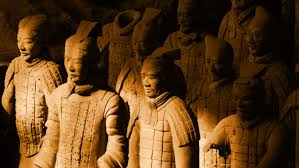
The Terracotta Army: An Eighth Wonder of the World, Yet Just a Glimpse into the Majesty of the Qin Shi Huang Mausoleum
The Terracotta Army: A Wonder Unveiled
The Terracotta Army, standing guard over the tomb of Qin Shi Huang, the first emperor of China, has captivated the world with its grandeur and intricate detail. Discovered in 1974 by farmers digging a well, this vast army of life-sized terracotta soldiers, horses, and chariots has been hailed as the "Eighth Wonder of the World." Each figure, with its unique facial features, hairstyle, armor, and weaponry, stands as a testament to the artistry and craftsmanship of the Qin dynasty.
A World Heritage Site of Immense Significance
Recognizing the immense historical and cultural significance of the Qin Shi Huang Mausoleum, which encompasses the Terracotta Army, UNESCO inscribed it as a World Heritage Site in December 1987. This prestigious designation acknowledges the site's "outstanding universal value" and its importance to the collective heritage of humanity. On July 25, 1991, a ceremony was held in Beijing to formally present the World Heritage certificate, marking the mausoleum's entry into an era of global protection and preservation.
A Mere Star in a Vast Celestial River
While the Terracotta Army is undeniably awe-inspiring, it represents just a fraction of the grandeur and scale of the entire Qin Shi Huang Mausoleum complex. Compared to the sprawling necropolis that lies beneath the earth, the Terracotta Army is akin to a single star in a vast celestial river. The mausoleum's central tomb, where the emperor himself is laid to rest, remains unexcavated, shrouded in mystery and legend.
Historical accounts describe the tomb as an extravagant microcosm of the emperor's empire, complete with a ceiling adorned with celestial bodies and a floor depicting the geography of his realm. Rivers of flowing mercury are said to represent the great waterways of China, while precious treasures and artifacts lie in wait, their splendor yet to be revealed. The sheer scale and opulence of the unexcavated tomb suggest that the Terracotta Army, magnificent as it is, may be merely a prelude to even more astonishing discoveries.
A Legacy for the Ages
The Qin Shi Huang Mausoleum, with its awe-inspiring Terracotta Army and the enigmatic secrets hidden within its depths, stands as a testament to the power, ambition, and artistic achievements of ancient China. It serves as a poignant reminder of a bygone era, captivating the imaginations of people worldwide and fueling an insatiable curiosity to uncover the mysteries that lie beneath the surface.
Q&A
Q: When was the Terracotta Army discovered?
A: The Terracotta Army was discovered in 1974 by farmers digging a well.
Q: Why is the Qin Shi Huang Mausoleum considered a World Heritage Site?
A: The Qin Shi Huang Mausoleum is considered a World Heritage Site because of its "outstanding universal value" and its significance to the collective heritage of humanity.
Q: What is believed to be inside the unexcavated central tomb of Qin Shi Huang?
A: Historical accounts describe the tomb as an extravagant microcosm of the emperor's empire, complete with a ceiling adorned with celestial bodies, a floor depicting the geography of his realm, rivers of flowing mercury, and countless treasures.